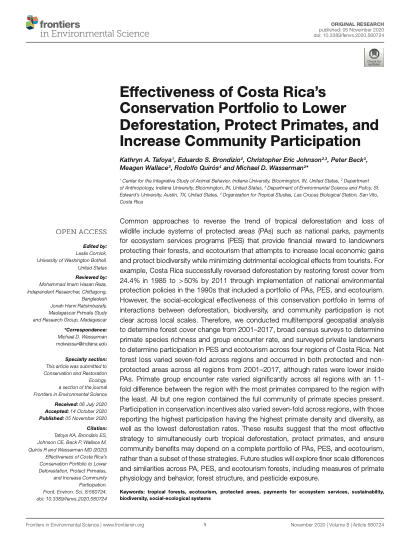Resource information
Common approaches to reverse the trend of tropical deforestation and loss of wildlife include systems of protected areas (PAs) such as national parks, payments for ecosystem services programs (PES) that provide financial reward to landowners protecting their forests, and ecotourism that attempts to increase local economic gains and protect biodiversity while minimizing detrimental ecological effects from tourists. For example, Costa Rica successfully reversed deforestation by restoring forest cover from 24.4% in 1985 to >50% by 2011 through implementation of national environmental protection policies in the 1990s that included a portfolio of PAs, PES, and ecotourism. However, the social-ecological effectiveness of this conservation portfolio in terms of interactions between deforestation, biodiversity, and community participation is not clear across local scales. Therefore, the authors conducted multitemporal geospatial analysis to determine forest cover change from 2001–2017, broad census surveys to determine primate species richness and group encounter rate, and surveyed private landowners to determine participation in PES and ecotourism across four regions of Costa Rica. Net forest loss varied seven-fold across regions and occurred in both protected and non-protected areas across all regions from 2001–2017, although rates were lower inside PAs. Primate group encounter rate varied significantly across all regions with an 11-fold difference between the region with the most primates compared to the region with the least. All but one region contained the full community of primate species present. Participation in conservation incentives also varied seven-fold across regions, with those reporting the highest participation having the highest primate density and diversity, as well as the lowest deforestation rates. These results suggest that the most effective strategy to simultaneously curb tropical deforestation, protect primates, and ensure community benefits may depend on a complete portfolio of PAs, PES, and ecotourism, rather than a subset of these strategies. Future studies will explore finer scale differences and similarities across PA, PES, and ecotourism forests, including measures of primate physiology and behavior, forest structure, and pesticide exposure.

